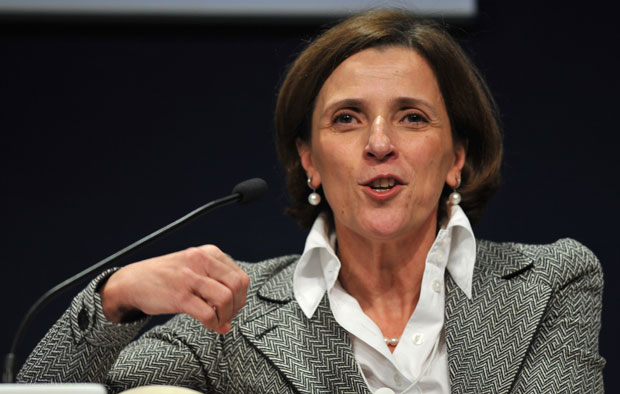
Hundreds of staff were given retrenchment notices this week or asked to reapply for their positions, while some were given immediate marching orders — a box to pack their personal belongings before leaving the building. Trade union Solidarity has put a video on YouTube of some of the scenes.
“It’s a new culture of how to get rid of staff in SA and it’s insensitive,” said Solidarity’s Dirk Hermann. “It’s the Barclays way of doing things. We don’t think it’s necessary to restructure.”
Cutting the fat
Although Absa is touting the restructuring as a “good news” story for its clients and the overall banking system, more pain is to come as Absa CEO Maria Ramos and her already leaner executive team have scrutinised every part of the business to cut all the fat.
“We will go area by area and understand how we will do business,” said Fergus Marupen, chief human resources executive of Absa. “At the end of the year, we would have fully aligned the business but, in the process, retrenchment will be the last resort. We’ve been trying to manage our turnover and head count very prudently.”
He said that Ramos had been in constant contact with the Reserve Bank about the restructuring and changes and there would be a shift to a more centralised system of functions such as human resources, back office and IT.
“We’ve been consistently saying we need to improve the effectiveness and efficiencies of the bank. Last year, when we integrated the businesses, we had two or sometimes three of every position,” Marupen said. “So, now that you’ve integrated business, the staff are feeling the full impact of this. Some have been moved to a lower level and some from one part of the business to another.”
Others’ roles had been changed, grades had been changed and some had to move to new business centres and provinces where their services were needed. “In IT, for example, there were 1 700 people but we only have jobs for 1 500 people. Everyone will have to reapply for their jobs.”
Marupen conceded that all IT staff members had been handed a letter saying they were on “reassignment” and, in three months’ time, they would know their fate — whether they were safe or the company was able to redeploy them elsewhere.
“We’re trying to handle this process as sensitively as possible. We have a reassignment centre where staff can get their CVs updated and where they can be redeployed. Only after that, then people will have to leave the organisation.”
Ramos’s restructuring experience
By the end of the year, Ramos’s three-year restructuring plan will culminate in a leaner bank at all levels. It is an exercise in which Ramos is well versed — she cleaned out the financial mess at Transnet and turned the parastatal around, before joining Absa in 2009.
When Ramos took over the hot seat from Steve Booysen, the bank was reeling from depressed income amid a global economic recession and its parent, Barclays, with headquarters in London, was in a precarious position because of the financial crisis.
A few months into the job, Ramos announced the bank’s intention to realign its operations and remove duplication. There were six business lines; now there are three divisions: retail and business banking, corporate investment banking and Absa financial services, which is the bank assurance unit.
But with the realignment has come a reduction in staff. For example, there were three chief executives in retail and business banking before the consolidation — Bobbie Malabie, Gavin Opperman and Daphne Motsepe. Opperman left in 2010 after reported clashes with Ramos over the restructuring and Motsepe took early retirement a month ago. Malabie is now heading the retail and business bank, which contributes about 80% of Absa’s revenues.
Others have also left in the process — two weeks ago, Absa chairperson Gareth Griffin announced he was stepping down after an 11-year tenure at the bank. It might have been coincidental that his decision was made in the week that Barclays CEO Bob Diamond and his lieutenants were in town for board meetings.
Apparently, the reorganisation has been so brutal that one Absa executive said: “Everyone is on tenterhooks. It’s a bit like the banking crisis in 2008 when bankers overseas would come to work every day not knowing if this was the day they would leave empty-handed. No one is safe.”
The joke doing the rounds inside the bank is that “if you can hang on for long enough, you can make CEO very quickly”.
Although Absa has said repeatedly it is not pandering to the whims of its controlling shareholder and is not in retrenchment mode, the bank’s annual reports show that, since the restructuring, the head count dropped from 43 239 in 2010 to 39 659 in 2011, a loss of 3 580 employees, which Absa attributes to the “impact of attrition and continued focus on automation and efficiency initiatives”.
Absa puts its natural attrition rate at about 10%, which is a point of contention with Solidarity.
SA to become Barclays’ African headquarters
There will be cuts in other places, too, as Absa realigns its business on the continent. SA will become the main hub for all Barclays’ activities in Africa, which is in line with moving its African operations from Dubai to Johannesburg last year.
Some other functions, such as some payroll activities, now being done from India, will also be moved to SA.
“No matter where someone is sitting in Africa, they will now get paid from SA. This is the new centralised model,” Marupen said.
Effectively, Absa will become a mini replica of Barclays, which is slashing costs to the bone in the face of regulatory pressure from the Financial Stability Board. It has to take fast, drastic steps before a critical stress test in October. This week, Diamond collapsed all of Barclays’ sub-brands, except for Absa and Barclays Card.
But Diamond was clear that Absa would not be affected because it was a separate legal entity with an executive board. “Absa is a well recognised brand in SA and Diamond recognises that,” said Absa spokesperson John Dludlu.
Why the consolidation now? “We needed to align the business with product lines,” Marupen said. “In each of those cases, they had their own back-office function but, when we looked at the clients, they were servicing the same clients.
“The end result is making sure clients have a more integrated way of how we deal with them.”
He said it was not about raising revenues but about running the bank more efficiently.
“And part of this process is gearing ourselves for expansion into Africa and aligning ourselves to capture some of the opportunities on the continent,” Marupen said.
This also means that Ramos has restructured the reporting matrix to give herself more time to grow the Africa portfolio. All the heads of the local businesses now have two reporting lines: the Absa Capital chief executive, for example, reports to Ramos on a broader macro level and reports directly to someone at Barclays in London.
Absa has said it is not so much about Barclays wanting to exercise control but more a case of “cross-leveraging and helping us to become a better organisation”.
There is speculation in Absa and Barclays that Ramos could be moved to the position of chairman, hence the new reporting lines. But Absa has thrown cold water on this rumour.
Marupen said the search for a new chairman started last week. Head-hunters were given a brief and were scouting for someone external, although Absa was looking at whether someone from its board might be suitable. The search was being driven by Brand Pretorius, who was on the board, he said.
Absa was looking for someone who “understands the banking environment because of the interesting legislation and regulatory environment, a South African because it’s the right thing to do”.
Suitable candidates also had to have the “necessary business acumen and leadership to lead the board”.
Absa has cast its search wide and was confident there would be South Africans who could fill the post but, Marupen said, they would consider someone from Barclays on the continent if a suitable South African could not be found.
The appointment is expected only in the second half of the year.
Barclays continues cuts to shore up capital
Barclays’s cost-slashing restructuring continued this week as it folded all businesses globally, including its investment banking arm, Barclays Capital, into the group as part of its “One Barclays” strategy. Absa and Barclays Card, regarded as two “unique” strong brands, escaped the shift.
All business lines will be moved to a centralised system in terms of human resources, emails, letterheads and research notes.
Already, more than 1 400 staff have been retrenched since the first half of last year. In August, Barclays cut 140 jobs when it combined the infrastructure of Barclays Corporate with Barclays Capital. More cuts are expected this year as Barclays further streamlines its operations and removes duplication.
Barclays is under pressure from the international Financial Stability Board to undertake sweeping reforms, or risk failing the next round of critical stress tests in October. The board has given 29 banks, including Royal Bank of Scotland, Lloyds TSB, HSBC and Barclays, until October to pass tests that will enable them to be safely dismantled if they went bust.
Barclays must carry out far-reaching restructuring to prove that it would not have to be supported by the government if it came close to collapsing. The current consolidation is crucial to it raising its capital and liquidity (cash-reserve) ratios.
The European Banking Authority, which conducted the last round of stress tests in November, put Barclays’ core tier-one capital (or the good capital) ratio at 7,8% at the end of December. Basel III requires banks to hold a core tier-one capital ratio of 10,8% and the authority’s requirement is 10%. At Barclays’s recent results presentation for the year ending December, the bank said it had now increased its core tier-one ratio to 11%.
Its liquidity pool, it said, remained resilient at £152bn and moved within a month-end range of £140bn to £167bn. Short-term funding was being rolled over despite the stress in the wholesale funding markets. About 93% of the pool comprised cash and deposits with central banks and government bonds.
Despite its gains on the capital and liquidity front, Barclays still took advantage of the European Central Bank’s second round of its long-term refinancing operation allocation in February. Barclays confirmed that it accessed €8,2bn of the central bank’s €500bn long-term refinancing three-year facility on 29 February.
The funds provided through this facility will be used to manage the risk associated with mismatches between Barclays euro-denominated assets and deposits in markets where Barclays has significant local operations, it said. About €6,2bn of the funds would be accessed through Banco de Espana and the remaining €2bn through Banco de Portugal for Barclays operations in those respective markets.
“This long-term facility will provide funding stability to those businesses while Barclays continues to reduce funding mismatches and restructure them to be fit for the new market reality,” it said.
“Until the funds are fully repaid, any funding benefit that might arise as a result of Barclays’s use of this facility — versus Barclays’ cost of funding — will be ring-fenced in Barclays’ financial results and will not contribute to staff remuneration.” — Sharda Naidoo, Mail & Guardian
- Visit the Mail & Guardian Online, the smart news source
- Image: World Economic Forum




